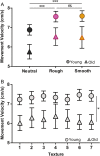The impact of movement sonification on haptic perception changes with aging
- PMID: 33664345
- PMCID: PMC7933169
- DOI: 10.1038/s41598-021-84581-3
The impact of movement sonification on haptic perception changes with aging
Abstract
Combining multisensory sources is crucial to interact with our environment, especially for older people who are facing sensory declines. Here, we examined the influence of textured sounds on haptic exploration of artificial textures in healthy younger and older adults by combining a tactile device (ultrasonic display) with synthetized textured sounds. Participants had to discriminate simulated textures with their right index while they were distracted by three disturbing, more or less textured sounds. These sounds were presented as a real-time auditory feedback based on finger movement sonification and thus gave the sensation that the sounds were produced by the haptic exploration. Finger movement velocity increased across both groups in presence of textured sounds (Rubbing or Squeaking) compared to a non-textured (Neutral) sound. While young adults had the same discrimination threshold, regardless of the sound added, the older adults were more disturbed by the presence of the textured sounds with respect to the Neutral sound. Overall, these findings suggest that irrelevant auditory information was taken into account by all participants, but was appropriately segregated from tactile information by young adults. Older adults failed to segregate auditory information, supporting the hypothesis of general facilitation of multisensory integration with aging.
Conflict of interest statement
The authors declare no competing interests.
Figures




Similar articles
-
It Sounds Cool: Exploring Sonification of Mid-Air Haptic Textures Exploration on Texture Judgments, Body Perception, and Motor Behaviour.IEEE Trans Haptics. 2024 Apr-Jun;17(2):237-248. doi: 10.1109/TOH.2023.3320492. Epub 2024 Jun 20. IEEE Trans Haptics. 2024. PMID: 37831581
-
Auditory adaptation improves tactile frequency perception.J Neurophysiol. 2017 Mar 1;117(3):1352-1362. doi: 10.1152/jn.00783.2016. Epub 2017 Jan 11. J Neurophysiol. 2017. PMID: 28077668 Free PMC article.
-
Paving the way for social touch at a distance: Sonifying tactile interactions and their underlying emotions.Proc Natl Acad Sci U S A. 2025 May 13;122(19):e2407614122. doi: 10.1073/pnas.2407614122. Epub 2025 May 6. Proc Natl Acad Sci U S A. 2025. PMID: 40327701
-
Using haptic stimulation to enhance auditory perception in hearing-impaired listeners.Expert Rev Med Devices. 2021 Jan;18(1):63-74. doi: 10.1080/17434440.2021.1863782. Epub 2020 Dec 29. Expert Rev Med Devices. 2021. PMID: 33372550 Review.
-
Multisensory integration: frequency tuning of audio-tactile integration.Curr Biol. 2009 May 12;19(9):R373-5. doi: 10.1016/j.cub.2009.03.029. Curr Biol. 2009. PMID: 19439261 Review.
Cited by
-
Midfrontal theta power encodes the value of haptic delay.Sci Rep. 2022 May 25;12(1):8869. doi: 10.1038/s41598-022-12911-0. Sci Rep. 2022. PMID: 35614196 Free PMC article.
-
Beyond sense-specific processing: decoding texture in the brain from touch and sonified movement.iScience. 2023 Sep 20;26(10):107965. doi: 10.1016/j.isci.2023.107965. eCollection 2023 Oct 20. iScience. 2023. PMID: 37810223 Free PMC article.
References
-
- Lederman, S. J. & Klatzky, R. L. Multisensory texture perception. In Handbook of Multisensory Processses 107–122 (eds. Calvert, E., Spence, C., Stein, B.) (2004).
Publication types
MeSH terms
LinkOut - more resources
Full Text Sources
Other Literature Sources
Medical

